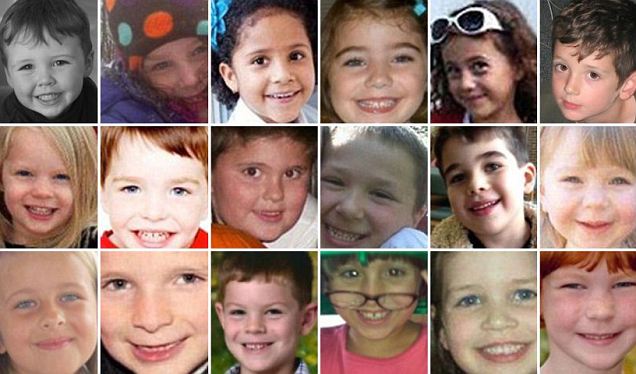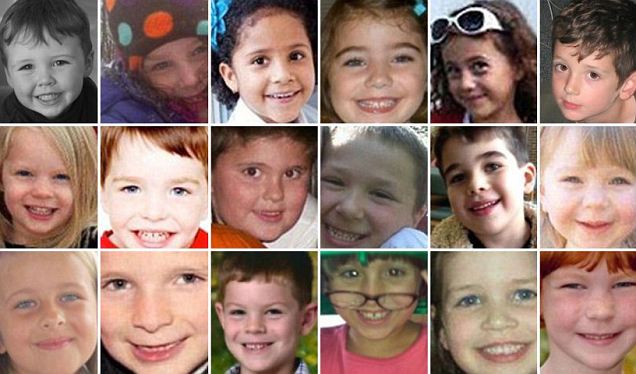(18 of the 20 children killed at Sandy Hook. Image courtesy of Island 106.)
In response to the killing of 20 children and four teachers, Dawn Hochsprung, the school’s beloved principal, and school psychologist Mary Sherlach at Sandy Hook Elementary School, the NRA’s Wayne LaPierre’s proposed stationing armed police, at taxpayer’s expense, in every school. We at Popular Logistics, think this wasn’t thought through – or is a “red herring” meant to distract people from the real problem – close to 300 million weapons in the hands of roughly 80 million people in the United States. given the number of weapons in the USA, the number of people with weapons, the ease and lack of oversight with which people can obtain weapons, the editors of Popular Logistics, as discussed here, believe that we need to think seriously about securing our schools.
(Note that the NRA’s executive offices are at 11250 Waples Mill Rd, Fairfax, VA, 22030. The NRA can be reached via telephone to 703-267-1250, via Fax to 703-267-3985, and via e-mail at nracrdf@nrahq.org)
As with commercial aviation safety, we should start by securing, or hardening our schools. Our “back of the envelope” calculation suggests that we can do this for about $40,000 per school, and therefore $5.6 Billion for the 140,040 schools in the United States. That will be explored in Part 3 of this series. This post continues the discussion of development of a squad of officers/agents for each school, begun in Part 1.
Each of these agents or officers needs to have:
- The skills of sky marshals – who mostly work posing as passengers or airport personnel.
- Fluency in the languages spoken by the children in the school population.
- The ability to be in a state of high vigilance and readiness while, at the same time, fitting into school environments
The NRA may want to cross-train teachers, support staff, and administrators; however, we know that the skills that make someone an effective teacher do not necessarily make someone an effective soldier and the training is very different. Each agent / officer will need an additional six months to a year of training and ongoing training each year.
Our goal is to make schools safer, and also to allow the children, teachers, staff, and parents to feel safer.
Furman’s initial post suggested that we would need 280,080 new police officers, at an annual cost of $22.7 Billion. On further analysis, Furman’s post from Dec. 27, 2012, is a starting point. However, while a two member team may be sufficient for many functions, two isn’t a minimum number for a serious security detail, even for the smallest schools. We would need a minimum of four officers per school for coverage from 7:00 AM to 8:00 PM, plus a fifth in the event that one of the four is sick or on vacation. These people would need much more training and more extensive selection than police officers. Since this is defensive, not offensive, the small-unit “light footprint” of Special Operations forces won’t work. Defenders haven’t the advantage of surprise. Let’s say four on duty, assume five days per week, and assume they’re going to have to start each day with making sure the school is clear of intruders who’ve come in overnight (as in the Sikh temple shooting), or secreted weapons, ammunition or explosives overnight.
We should also consider that these officers would need high proficiency in such skills as negotiations and hostage rescue. These are hard to acquire and must be maintained. US Navy SEALs follow a regimen, after their initial training, of one day of training for every three days in the field. We should assume one day training per week. These teams need to train together. Thus, each school’s team can only work four days out of five, the fifth being a training day. So for four schools, we’d need five teams. The fifth team would rotate between schools, giving School A’s team the day clear for training Fridays, for School B’s team Thursday, and so on, and allowing the floating team to train on Mondays.
| Security Team Schedules | |||||
| Location | Mon | Tues | Wed | Thu | Fri |
| PS 1 | Alpha | Alpha | Alpha | Alpha | Zulu |
| PS 2 | Bravo | Bravo | Bravo | Zulu | Bravo |
| Middle School | Charlie | Charlie | Zulu | Charlie | Charlie |
| High School | Delta | Zulu | Delta | Delta | Delta |
| Training | Zulu | Delta | Charlie | Bravo | Alpha |
| Table 1. | |||||
That would be 25 police officers per every set of four schools, or 6.25 per school.
Assuming these officers are paid $50,000 per year, plus benefits, and provided with uniforms, including body armor, extensive training at $30 per agent per school, similar to graduate school tuition, weapons, ammunition, electronics, and vehicles, estimated at $104,875 per officer per year, as outlined in Table 2.
| Estimated cost for Police Officer | |
| Officers | |
| Salary | $50,000 |
| Benefits | $15,000 |
| Training for School Security | $30,000 |
| Uniform | $500 |
| Body Armor | $1,000 |
| Electronics | $2,000 |
| Vehicle | $4,000 |
| Weapons | $1,000 |
| holster | $125 |
| Ammunition | $1,250 |
| total | $104,875 |
| Table 2 | |
Considering that there are 140,040 schools in the United States, we would need 875,250 additional police officers, an increase of 110% over the current population of 794,300 officers, at an annual cost of an additional $91.8 Billion, as outlined in tables 3 and 4.
| K-12 Schools in the US | |
| Public Schools | 98,706 |
| Charter Schools | 5,714 |
| Private Schools | 28,220 |
| Catholic Schools | 7,400 |
| total | 140,040 |
| Table 3 | |
| Budget | |
| Total K – 12 Schools | 140,040 |
| Per Police Officer | $104,875 |
| Officers per school | 6.25 |
| New Officers | 875,250.0 |
| Per School | $655,469 |
| total | $91,791,843,750 |
| Table 4 | |
Note that sworn officers of most agencies are paid by the hour and time and a half for overtime. Navy SEALs, Special Forces, Delta – all salaried military, and they don’t get overtime for long days or cancelled leave.
The training in all phases is dangerous, and needs qualified, experienced instructors; as noted above, it requires specialized facilities. The NYPD – the best-funded and largest non-federal law enforcement agency in the United States – doesn’t have adequate trainers or facilities. The best facilities in the country, apart from military facilities include:
- The Federal Law Enforcement Training Center (FLETC) at Glynco, Georgia; this is the training facility for most federal law enforcement agencies other than the FBI or US Secret Service, such as the U.S. Marshals Service
- The FBI’s facility at Quantico, Virginia (space shared with the United States Marine Corps
- The Secret Service has a substantial facility at Beltsville, Maryland
Since Sept. 11, these have been overstretched. However, assuming those facilities have the capacity to add large numbers of new students, an assumption that is probably incorrect, are we going to start flying these new school security officers to Glynco, Quantico, and Beltsville, on a weekly basis? Or will we build – and staff – local training centers? Or should we regulate handguns, military rifles, and ammunition the way we regulate knives such as switchblades?

– Part 2 of a series.
See also
- L. J. Furman, July 30, 2012, The Second Amendment Revisited
- L. J. Furman, August 1, 2012, Justice Scalia on the Second Amendment
- L. J. Furman, Dec. 27, 2012, An Armed Police Presence in Every School
- L. J. Furman & J. Soroko, Dec. 31, 2012, Securing our Schools, Part 2, this post.
– Lawrence J. Furman holds a Bachelor’s in Biology and an MBA in “Managing for Sustainability.” Jonathan Soroko, Esq, is an attorney in private practice.
